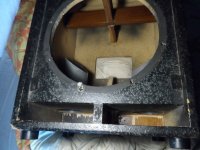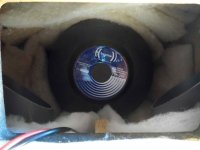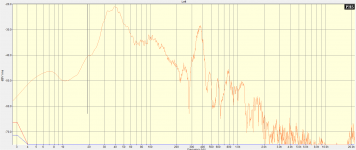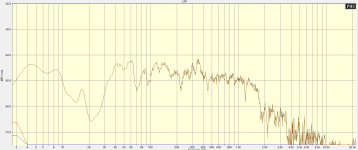I've recently come across the idea of adding a Helmholtz Resonator to a speaker cabinet. I can't find much information about it though. I've thought through how it might work. It seems that when it resonates, it does so in phase with the driver. So it draws air into it's chamber as the cone moves backwards and pushes air out as the cone moves out. It makes it easier for the cone to move, so you get more displacement for a given electrical power. All very nice. I can design a resonator for a given frequency, that's easy enough, but there are still things I need to know.
How does the size of the port affect the cabinet? Does a bigger port and cavity mean a bigger effect on output? That would seem to make sense.
What is the Q of a resonator? I would need to know this to know how low before the cabinet's F3 I'd need to tune it in order to get a flat response.
Am I right in thinking it would act a bit like a reflex port, in that you get bass extension, but it takes a few cycles to start to resonate, you the bass is less responsive?
How does the size of the port affect the cabinet? Does a bigger port and cavity mean a bigger effect on output? That would seem to make sense.
What is the Q of a resonator? I would need to know this to know how low before the cabinet's F3 I'd need to tune it in order to get a flat response.
Am I right in thinking it would act a bit like a reflex port, in that you get bass extension, but it takes a few cycles to start to resonate, you the bass is less responsive?
I've recently come across the idea of adding a Helmholtz Resonator to a speaker cabinet. I can't find much information about it though. I've thought through how it might work. It seems that when it resonates, it does so in phase with the driver. So it draws air into it's chamber as the cone moves backwards and pushes air out as the cone moves out. It makes it easier for the cone to move, so you get more displacement for a given electrical power. All very nice. I can design a resonator for a given frequency, that's easy enough, but there are still things I need to know.
How does the size of the port affect the cabinet? Does a bigger port and cavity mean a bigger effect on output? That would seem to make sense.
What is the Q of a resonator? I would need to know this to know how low before the cabinet's F3 I'd need to tune it in order to get a flat response.
Am I right in thinking it would act a bit like a reflex port, in that you get bass extension, but it takes a few cycles to start to resonate, you the bass is less responsive?
All cabinets of BR speakers (bass reflex) use the principle of the Helmhotz resonator, that is, the tuning tube.
You can use a simulation program like WinIsd, and have the TS data of the speaker you want to use.
Bass reflex speaker design – easy explanation – Audio Judgement
I think the basic principles are outlined here:
Engineering Acoustics/Noise control with self-tuning Helmholtz resonators - Wikibooks, open books for an open world
Engineering Acoustics/Noise control with self-tuning Helmholtz resonators - Wikibooks, open books for an open world
I will read the link of galu, the first question that arises is:
Another resonator to tune another speaker in the same cabinet? Which one ? Double tuning in the twoofer? Nothing new under the sun. It is usual to do it with the twoofer, but there are new designs (Troels uses it a lot) in which a specific tuning tube is used for the midrange speaker. With its specific compartment. The usual thing was that it worked in a sealed compartment, but because sizes greater than 5 or 6 inches were not used for speakers of specific medium ranges. And we can also leave it (against the sanctified theory that the media speaker must be isolated from the tweeter and the twoofer) in a total interaction, as in DTQWTII. After all, a Lowther is a simple RE with whizzer .... all the rest does the cabinet development, right?
I hasten to clarify that it is not so simple, it is a magnetic beast that pushes up the medium / high spectrum .....
Another resonator to tune another speaker in the same cabinet? Which one ? Double tuning in the twoofer? Nothing new under the sun. It is usual to do it with the twoofer, but there are new designs (Troels uses it a lot) in which a specific tuning tube is used for the midrange speaker. With its specific compartment. The usual thing was that it worked in a sealed compartment, but because sizes greater than 5 or 6 inches were not used for speakers of specific medium ranges. And we can also leave it (against the sanctified theory that the media speaker must be isolated from the tweeter and the twoofer) in a total interaction, as in DTQWTII. After all, a Lowther is a simple RE with whizzer .... all the rest does the cabinet development, right?
I hasten to clarify that it is not so simple, it is a magnetic beast that pushes up the medium / high spectrum .....
A simple vented enclusure has no point, unless increased efficiency and output are being seeked.
Technically a simple vented enclosure is a transmission line.
The port will show several resonant modes, which can be tweaked in many ways, with the lowest related to constant volume air compression (heat), and the rest related to sound propagation, combing, and diaphragm loading.
Technically a simple vented enclosure is a transmission line.
The port will show several resonant modes, which can be tweaked in many ways, with the lowest related to constant volume air compression (heat), and the rest related to sound propagation, combing, and diaphragm loading.
The most difficult case for a normal vented enclosure is the "high-output 2-way full-range" application.
The two pictures show a prototype speaker (vintage, modified).
For port standing waves:
- The location where the mouth of the ports exits inside the enclosure matters.
- The distance to the cone also matters.
- The optimum shape of the port is not necessarily straight or constant section.
- The optimum cut of the mouth is not neccessarily perpendicular.
- Location and amount of stuffing matters.
A Q over 3 in main resonant mode usually does not sound good.
Port standing waves do not sound good.
Frequency response plots are:
- Response at half way of port (in-room).
- Response at half way between (20cm to) port and (20cm to) speaker (in-room).
(The bump at 360Hz is the standing wave due to enclosure height being ~48cm.)
Distortion is the other parameter to consider. However, this is well explained in other sources.
The two pictures show a prototype speaker (vintage, modified).
For port standing waves:
- The location where the mouth of the ports exits inside the enclosure matters.
- The distance to the cone also matters.
- The optimum shape of the port is not necessarily straight or constant section.
- The optimum cut of the mouth is not neccessarily perpendicular.
- Location and amount of stuffing matters.
A Q over 3 in main resonant mode usually does not sound good.
Port standing waves do not sound good.
Frequency response plots are:
- Response at half way of port (in-room).
- Response at half way between (20cm to) port and (20cm to) speaker (in-room).
(The bump at 360Hz is the standing wave due to enclosure height being ~48cm.)
Distortion is the other parameter to consider. However, this is well explained in other sources.
Attachments
There are some rare designs which use additional Helmholtz resonator for damping drivers high-Q resonance. See the design and the descriptions:
SOLO 100 | Visaton
SOLO 50 | Visaton
So... here the Helmholtz resonator is used as a bass trap inside the speaker box.
SOLO 100 | Visaton
SOLO 50 | Visaton
So... here the Helmholtz resonator is used as a bass trap inside the speaker box.
Are you referring to internal Helmholtz absorbers (IHA)? They are used to absorb energy at a narrow frequency band, usually to reduce the effect of unwanted resonances in loudspeaker enclosures. An IHA works by tuning it to the frequency of the specific resonance and stuffing it with a lot of absorbing material (wool or similar) in order to convert the sound energy at the tuning frequency to heat. The author of the German DIY magazine "Hobby Hifi" makes use of IHAs quite often, and he wrote some descriptions about IHAs that are quite useful.
Are you referring to internal Helmholtz absorbers (IHA)? They are used to absorb energy at a narrow frequency band, usually to reduce the effect of unwanted resonances in loudspeaker enclosures. An IHA works by tuning it to the frequency of the specific resonance and stuffing it with a lot of absorbing material (wool or similar) in order to convert the sound energy at the tuning frequency to heat. The author of the German DIY magazine "Hobby Hifi" makes use of IHAs quite often, and he wrote some descriptions about IHAs that are quite useful.
Somewhat the opposite. I don't want to absorb the sound energy, so much as boost it. I'm wondering if a resonator can reduce the load on a driver, in a way analogous to impedance matching, and so let the cone move more at the tuned frequency.
I've done something similar in the past with an engine induction system. At resonance, the tuned cavity is pushing its air out at the same time the engine's intake valve opens. The tuned cavity draws air back in when the valve is closed. It helps fill a dip in torque in an engine where it can't breathe efficiently on its own. It seems right that perhaps it could help a speaker in the same way.
In the Seventies, Dynaco sold speakers which had this internal Helmholtz resonator, calling it "sealed aperiodic enclosure" or some such. I'm thinking of their A35 and A50 models, in which the cabinet was internally divided into 2 chambers, linked by a tuned slot. The intended effect was to tame the woofer resonance in the cabinet, controlling cone movement and evening out the impedance curve. By all accounts this was effective. I'm certainly going to investigate this further. Cheers.
Hi,
French's brand Elipson used triple resonnators in the 70's and results was great from the examples i've heard. Briggs and Fostex used double resonators too but it seems triple yield better results ( ive not heard Fostex DBR or Briggs). The target seems different though : Fostex goal is to expand low end response, Elipson to 'clean up' low mid.
Here is an analysis and example ( in french but translator should make it, it is well written in french):
Enceinte bass-reflex à résonateur et filtre de BRIGGS
French's brand Elipson used triple resonnators in the 70's and results was great from the examples i've heard. Briggs and Fostex used double resonators too but it seems triple yield better results ( ive not heard Fostex DBR or Briggs). The target seems different though : Fostex goal is to expand low end response, Elipson to 'clean up' low mid.
Here is an analysis and example ( in french but translator should make it, it is well written in french):
Enceinte bass-reflex à résonateur et filtre de BRIGGS
Smart51, the way Dynaco used the idea was to achieve the opposite of what you are trying to do. In their A35 and A50s the Helmholtz resonator acted against the woofer's natural resonance. This was to eliminate 'boominess' in the sound, and present a more constant load to the amplifier. The result was a very accurate speaker in the bass region. I still think it was a brilliant idea.
Somewhat the opposite. I don't want to absorb the sound energy, so much as boost it. I'm wondering if a resonator can reduce the load on a driver, in a way analogous to impedance matching, and so let the cone move more at the tuned frequency.
I've done something similar in the past with an engine induction system. At resonance, the tuned cavity is pushing its air out at the same time the engine's intake valve opens. The tuned cavity draws air back in when the valve is closed. It helps fill a dip in torque in an engine where it can't breathe efficiently on its own. It seems right that perhaps it could help a speaker in the same way.
hi, did you come up with a satisfactory explanation why the same element can act as a sound energy booster but also as a sound energy absorber? I have also been adding HR to engine induction systems in order to reduce specific frequencies. However if you take the same element and you blow across its neck, it produces sound at that frequency instead of attenuating it. How is that possible?
It is not the same element.hi, did you come up with a satisfactory explanation why the same element can act as a sound energy booster but also as a sound energy absorber? I have also been adding HR to engine induction systems in order to reduce specific frequencies. However if you take the same element and you blow across its neck, it produces sound at that frequency instead of attenuating it. How is that possible?
The Helmholtz resonator determines the frequency of the resonance.
The absorbing material absorbs the sound energy.
It is not the same element.
I am referring to his experiment with the engine induction system, where he used a tuned cavity = a helmholtz resonator (or a quarter wave).
The Helmholtz resonator determines the frequency of the resonance.
The absorbing material absorbs the sound energy.
I know that, but that's not what I asked.
- Status
- This old topic is closed. If you want to reopen this topic, contact a moderator using the "Report Post" button.
- Home
- Loudspeakers
- Multi-Way
- What effect of adding a Helmholtz Resonator to a cabinet?



